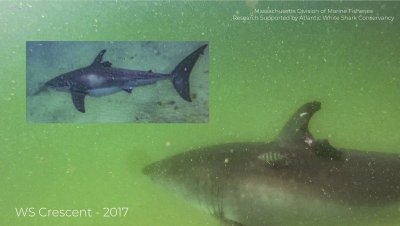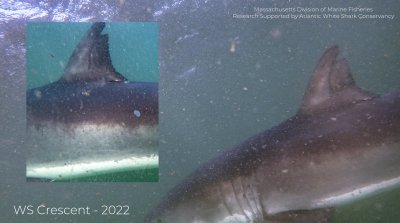When we picture great white sharks, we tend to think of their razor-sharp teeth, their enormous size—up to nearly 20 feet long—their keen sense of smell, and perhaps the Jaws theme music. Their remarkable powers of self-healing, however, tend to slide under the radar.
This impressive ability was recently showcased in photos, shared by the Atlantic White Shark Conservancy on Twitter. The post offers two images of a great white shark called Crescent: the first, taken in 2017, shows Crescent with serious injuries including a split in his dorsal fin; the second, taken in 2022, shows Crescent with a fin that has "zipped" itself back up.



"Rapid healing of substantial wounds in several shark species has been observed frequently by researchers," Mahmood Shivji, a shark researcher at Nova Southeastern University, Florida, and director of Save Our Seas Foundation Shark Research Center, told Newsweek.
"There are over 500 known shark species, and most have not been studied with regard to wound healing, but it is thought that this remarkable property is widespread in sharks and their close relatives, the rays."
The exact biological mechanisms for this capability are not fully understood but, in 2019, Shivji and colleagues published a study exploring the genetics of this impressive adaptation.
"We found that advantageous genetic changes had occurred in the DNA sequence of several genes, and there was also an enrichment of several genes that play fundamental roles in wound healing in humans," Shivji said.
One of the genes identified is known to be involved in the production of a key component of blood clotting, which is involved in wound healing in humans too. "These adaptations and enrichments of essential wound-healing genes may underlie the ability of sharks to heal from wounds so efficiently," Shivji said.
Why sharks have evolved to develop this impressive ability is not known, but Shivji said that it could have something to do with shark mating. "During copulation, male sharks grab hold of females with their mouths—[they] essentially bite them—to hold on to them during copulation. Given most sharks have sharp teeth, this biting results in significant wounds to the female, which have to heal without getting infected—hence the ability to heal efficiently from wounds."
Sharks are not unique in their wound-healing abilities, and many other animals are able to regenerate missing body parts as well. Axolotls, aquatic amphibians that can breathe underwater, are a particularly impressive specimen in this regard, and are able to regrow their tails, limbs, spinal cord and even their brains.

Understanding the genetic and biological mechanisms underpinning these abilities in animals could help us develop better wound-healing treatments for humans. "Most fundamental discoveries of genetic and biochemistry mechanisms underlying life have first been made in non-human model systems, and it's turned out that many of these mechanisms are conserved even in humans," Shivji said.
Great white sharks are classed as being "vulnerable" to extinction by the International Union for Conservation of Nature. Many of the greatest threats to this species have been caused by humans, for example habitat disruption, loss of prey due to overfishing and climate change.
"There are remarkable biological properties that have evolved in non-human animals, and we've only just scratched the surface of our knowledge of these properties, many of which could be helpful for improving human medicine," Shivji said. "This is one additional reason why it's so important to conserve our natural world and the brilliant evolutionary diversity that exists."
Do you have an animal or nature story to share with Newsweek? Do you have a question about great white sharks? Let us know via science@newsweek.com.
References
Marra NJ, et al., White shark genome reveals ancient elasmobranch adaptations associated with wound healing and the maintenance of genome stability, PNAS, February 19 2019, https://doi.org/10.1073/pnas.1819778116
Uncommon Knowledge
Newsweek is committed to challenging conventional wisdom and finding connections in the search for common ground.
Newsweek is committed to challenging conventional wisdom and finding connections in the search for common ground.
About the writer
Pandora Dewan is a Senior Science Reporter at Newsweek based in London, UK. Her focus is reporting on science, health ... Read more





